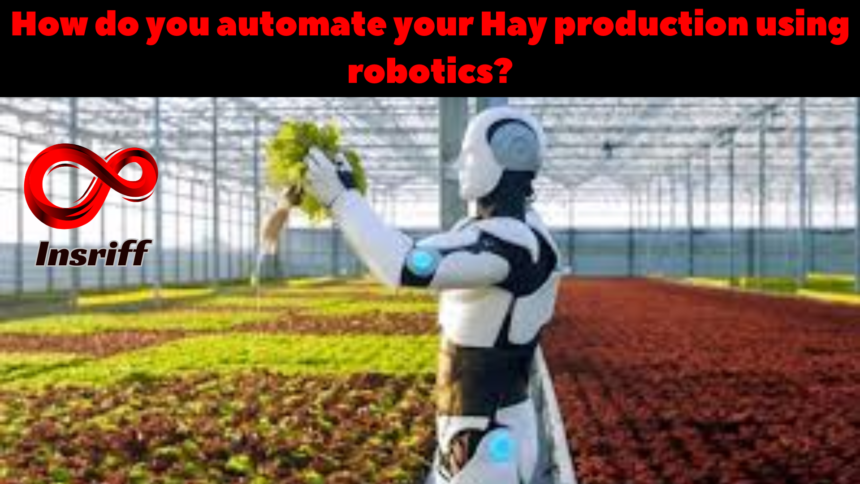The agricultural industry is unexpectedly evolving, and one of the most thrilling frontiers is using robotics to automate responsibilities that were once achieved by hand. The production of hay, especially Timothy hay, requires a lot of work, so this is the main reason why we need to boost hay production using robotics.
Benefits of Automating Hay Production with Robotics
There are many benefits to automating alfalfa and timothy hay manufacturing with robotics. Some of the most great advantages include:
- Increased efficiency: Robots can paint 24/7 without breaks, considerably increasing the speed and performance of hay production.
- Reduced exertion prices: Robotic systems can replace human exertions, which could assist in lessening the prices of hard work.
- Improved protection: Hay production can be a dangerous activity, however robots can assist in lessening the hazard of injuries to people.
- Higher quality hay: Robotic systems can be programmed to perform tasks with greater precision than people, which can lead to higher fine hay.
- Reduced environmental effect: Robotic systems can help to reduce the environmental impact of hay manufacturing with the aid of the use of less fuel and water.
Types of Robots Used in Hay Production
There are a whole lot of robots that can be utilized in hay manufacturing. Some of the most common varieties of robots used in alfalfa and timothy hay manufacturing include:
1. Mowing robots
These robots might mow hayfields. They are programmed to travel along particular routes to guarantee that the entire discipline is mowed irresponsibly.
2. Tedding robots
These robots may utilize the Ted hay system, which spreads the hay out to dry. Tedding helps to save the hay from moulding and guarantees that it dries lightly.
3. Raking robots
Long rows of hay that are ready for baling are called windrows. They are used to rake hay into these robots.
4. Baling robots
These robots are capable of baling hay, which is the process of compressing hay into easily transportable and reusable bales.
Challenges of Automating Hay Production with Robotics
While there are numerous benefits to automating hay manufacturing with robotics, there are also some challenges. Some of the most commonplace challenges include:
1. High preliminary value
Robotic structures may be costly to buy and maintain.
2. Technical complexity
Robotic systems can be complicated to function and hold, which could require farmers to invest in schooling.
3. Limited availability
Robotic structures for hay manufacturing are nonetheless pretty new, and they’ll no longer be effective to be had in all areas.
How do you start hay production using robotics?
If you’re interested in automating your hay production with robotics, here are the few most important things that you need to know.
Do your research
There are a lot of robotic systems available on the market, so it is essential to do your studies to discover the right system for your needs.
Talk to your local dealer
Your local farm device dealer may be a precious source of information and recommendations on robotic systems for hay manufacturing.
Start small
You do not need to automate your whole hay manufacturing operation in a single day. Start by automating one or two duties, and then you could step by step add more robots as you advantage experience.
The Future of Hay Production with Robotics
The use of robotics in hay production is still at its early levels. However, it has the capacity to revolutionize the industry. As robot systems end up extra low-priced and easier to apply, we anticipate peering increasingly farmers automating their hay production operations.
Hay production is being automated using a variety of technologies in addition to the particular robots mentioned above. These technologies consist of:
GPS-primarily based guidance systems
These methods are applied as manual tractors. Thus, the other machines attempt to detect distinct courses in the subject.
Sensors
Sensors gather data on the hay’s moisture content, nutrient content, and other attributes. It is based on these statistics. Therefore, it is possible to optimize hay output by adjusting the parameters of robot systems.
Artificial intelligence (AI)
While mowing or tying the hay, AI is growing accustomed to developing robotic structures that can make decisions alone or collaboratively. As those technologies continue to expand, we expect to see even greater automation in hay manufacturing. This will help to make the industry more green.
Conclusion
Revolutionize hay production with robotics for increased efficiency, lower labor costs, improved safety, and higher quality hay. Explore harvesting, tedding, raking, and baling robots while tackling problems like startup expenses and technical complexity. As the enterprise evolves, embrace the future of hay manufacturing with rising technologies including GPS guidance, sensors, and AI, paving the way for an extra sustainable and efficient agricultural future.







